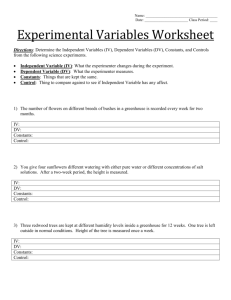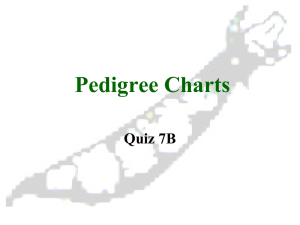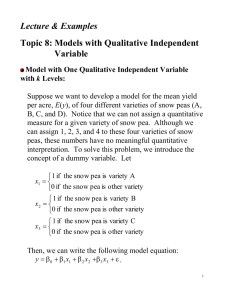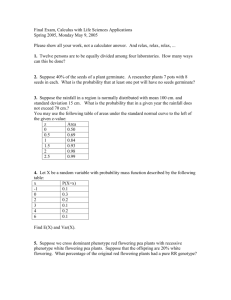final_report_oilseed
advertisement
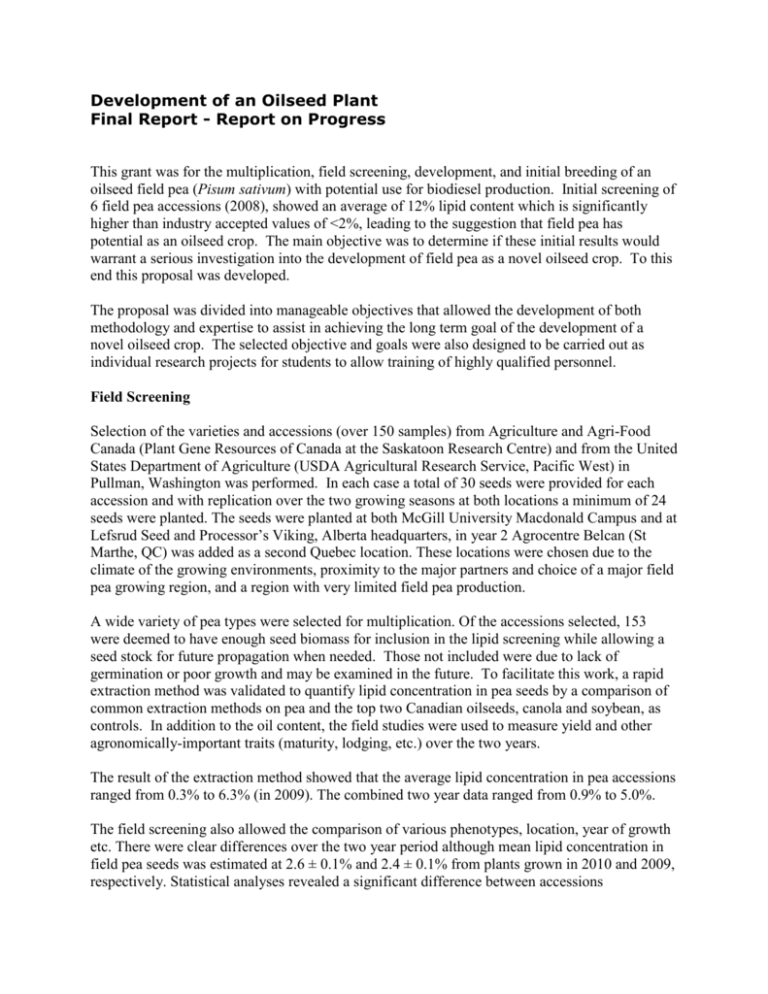
Development of an Oilseed Plant Final Report - Report on Progress This grant was for the multiplication, field screening, development, and initial breeding of an oilseed field pea (Pisum sativum) with potential use for biodiesel production. Initial screening of 6 field pea accessions (2008), showed an average of 12% lipid content which is significantly higher than industry accepted values of <2%, leading to the suggestion that field pea has potential as an oilseed crop. The main objective was to determine if these initial results would warrant a serious investigation into the development of field pea as a novel oilseed crop. To this end this proposal was developed. The proposal was divided into manageable objectives that allowed the development of both methodology and expertise to assist in achieving the long term goal of the development of a novel oilseed crop. The selected objective and goals were also designed to be carried out as individual research projects for students to allow training of highly qualified personnel. Field Screening Selection of the varieties and accessions (over 150 samples) from Agriculture and Agri-Food Canada (Plant Gene Resources of Canada at the Saskatoon Research Centre) and from the United States Department of Agriculture (USDA Agricultural Research Service, Pacific West) in Pullman, Washington was performed. In each case a total of 30 seeds were provided for each accession and with replication over the two growing seasons at both locations a minimum of 24 seeds were planted. The seeds were planted at both McGill University Macdonald Campus and at Lefsrud Seed and Processor’s Viking, Alberta headquarters, in year 2 Agrocentre Belcan (St Marthe, QC) was added as a second Quebec location. These locations were chosen due to the climate of the growing environments, proximity to the major partners and choice of a major field pea growing region, and a region with very limited field pea production. A wide variety of pea types were selected for multiplication. Of the accessions selected, 153 were deemed to have enough seed biomass for inclusion in the lipid screening while allowing a seed stock for future propagation when needed. Those not included were due to lack of germination or poor growth and may be examined in the future. To facilitate this work, a rapid extraction method was validated to quantify lipid concentration in pea seeds by a comparison of common extraction methods on pea and the top two Canadian oilseeds, canola and soybean, as controls. In addition to the oil content, the field studies were used to measure yield and other agronomically-important traits (maturity, lodging, etc.) over the two years. The result of the extraction method showed that the average lipid concentration in pea accessions ranged from 0.3% to 6.3% (in 2009). The combined two year data ranged from 0.9% to 5.0%. The field screening also allowed the comparison of various phenotypes, location, year of growth etc. There were clear differences over the two year period although mean lipid concentration in field pea seeds was estimated at 2.6 ± 0.1% and 2.4 ± 0.1% from plants grown in 2010 and 2009, respectively. Statistical analyses revealed a significant difference between accessions (p<0.0001), the growing year (p=0.0002) and the interaction between the two factors (p <0.0001). Further analysis of variance revealed a significant difference between the different classes of seed shape (p= 0.001) but cotyledon color, flower color, plant height and mass of 100 seeds had no effect on the total lipid production in pea seeds. There was a significant difference between wrinkled seeds and round seeds (p=0.0007) as well as wrinkled seeds and medium seeds (p=0.0008), but the difference between medium and round seed was not statistically significant. Wrinkled seeds were found to have a greater lipid deposit (2.8 ± 0.1) as compared to medium (2.3 ± 0.1) and round seeds (2.4 ± 0.1). This CRD grant has allowed the selection of a variety of field pea accessions that were used for initial breeding, for the development of an oilseed pea. Lipid Content Screening All seeds were processed at McGill University for lipid content determination. Initial tests were carried out using 5 solvents systems to determine an optimum system for field pea lipids. The solvent systems were evaluated with both canola and soybean as control. The methods included butanol, hexane/isopropanol, Bligh & Dyer method (chloroform), and soxhlet extraction with petroleum ether or hexane. Microwave extraction was performed but did not result in consistent lipid content measurements and was removed from the tests. The optimal method selected involved a mixed solvent extraction method (hexane/isopropanol) although butanol extraction was similar. The inherent toxicology associated with the Bligh & Dyer method, although slightly superior to the other extraction methods led to its exclusion. The soxhlet extraction methods were surprisingly poor, due either to the type of lipids within field pea or a method limitation. Finally, the results showed that among the selected methods, the butanol and the hexane/isopropanol methods were the most convenient, extraction methods, and were employed for the lipid screening for oil seed studies. The total lipid analysis is a useful tool for selecting accessions for further plant breeding, however; the composition of the lipid material is also important if field pea were to become an important oilseed crop. To this end a method was developed in-house for fatty acid profiling of the seed oils of some of the selected varieties of field peas by RP-LC/ESI-MS/MS. The fatty acid profile of the different varieties of field pea were analyzed as well as samples of canola and soybean for comparison . The total level of saturated fatty acids (SFAs) was between 15% and 20% in the pea varieties, but, by comparison, was only 11% in the canola sample. Total mono-unsaturated fatty acids (MUFAs) ranged from 27% to 37% in field peas. Finally, poly-unsaturated fatty acids (PUFAs) ranged from 42% to 57%., of which linoleic acid (C18:2) was the major component in field peas. The most abundant PUFA in all samples was linoleic acid, accounting for approximately 40% of total lipids in all pea varieties; for MUFA, oleic acid; and SFA, palmitic acid (C16:0). Unknowns were also seen in many of the samples, but their relative concentrations were low (less than 1.5%). Their identity is under investigation and may form the basis of another project. Specific lipids concentrations varied throughout the pea samples; palmitic acid was detected in all field pea varieties but was measured in one variety at 9%. Stearic acid (C18:0) was found to be higher in a different variety at 6.3%. Arachidic acid (C20:0) was present in all pea samples at relative low levels of 1% to 2%. Behenic acid (C22:0), known to be difficult for human and animal digestion occurred in field pea samples at low levels, between 0.5% to 1.2%. These low levels highlight the fact that pea oil could be utilized in the food industry. Another SFA found, lignoceric acid (C24:0) is a long chain fatty acid, at levels up to 4%, has rarely been reported for field pea but has been found in other members of the Leguminosae. The major MUFA found in all pea samples was oleic acid, up to 36% for one variety. Others found included gadoleic acid (C20:1), up to 1.5%, and erucic acid (C22:1) acid, with a maximum of level of 0.5%. Nervonic acid (C24:1) was not detected in field peas, but was present in canola at a level of 0.50%. A simple and rapid methodology by LC/ESI-MS/MS for the characterization of fatty acids from pea oil samples was developed. The procedure was tested with soybean and canola oils showing the possible application for oilseed investigation of fatty acids. Sample preparation and manipulation was minimal and extracts were clean enough for analysis. Compared to methods such as GC-FID or LC-UV/Vis, chemical derivatization was not necessary, thereby decreasing the likelihood of unwanted effects like racemization and/or oxidation. Generally the following fatty acid composition was obtained in raw pea: C18:2 > C18:1 > C16:0 > C18:3 > C18:0. This fatty acid profile suggests that the species of field pea investigated may have the potential to be used as raw materials to develop a commercially accepted oilseed crop, as the oil composition of field pea fits the food industry perfectly. Although the MS method allows the determination of the components of the oil fraction, it does not allow the actual quantification of the triglycerides, diglycerides, and other minor components. To accomplish this, an external laboratory has been engaged to help fully characterize the oil sample; results are pending. These results are important in positioning field pea a potential oilseed crop. The variability of the lipid profile amongst field pea samples suggests that the lipid content can likely be manipulated. This highlights the importance of the genetic studies of field pea, its breeding, and the subsequent optimization of its oil content. The broad range of seed lipid concentration in pea cultivars and wild accessions reported here supports the potential of peas to bio-synthesize and store lipid in the seeds. This characteristic, overlooked in the past, could be enhanced by breeding approaches similar to those accomplished for canola and soybean. The CRD project has allowed the development of a methodology to assess the field pea oils’ feasibility in the food industry and to allow screening of oil and lipid content during the various stages of the plant breeding. This method will allow the correlation of the genetic information as it relates to the accumulation of the various fatty acids. Selection of Candidate Lines From the lipid results obtained six accessions were selected for the breeding program Germplasm Improvement In order to facilitate the breeding and the further development of field pea as a potential oilseed crop, genetics are clearly important. To this end a method was developed to try and understand the genetic diversity of field peas, as understanding the genetic diversity of different Pisum accessions. Among various molecular markers developed, microsatellites or SSR markers have recently gained importance due to their accuracy, reliability, co-dominancy, reproducibility and high polymorphism. The objective was to assess genetic diversity in the pea germplasm through microsatellites molecular markers. For this purpose, 15 SSR markers covering various chromosomes were assessed across 35 diverse Pisum accessions. These SSR markers were found to be highly polymorphic, amplifying a total of 41 alleles and able to differentiate between 35 Pisum cultivars. SSR markers were scored by their polymorphic information content (PIC), with a range of 0.055 (AA206) to 0.660 (AB72) with an average of 0.460, and by their discriminating power (D), which ranged from 0.057 (AA206) to 0.679 (AB72) with an average of 0.475. Genetic similarity values of Pisum accessions ranged from 0.075 to 0.875. The ability of these SSR markers to generate such low genetic similarity values illustrates the utility of SSRs markers in conservation, breeders’ rights protection, genetic purity analysis, gene mapping, marker assisted selection (MAS) and novel cultivar breeding pursuits. This methodology has been used successfully in soybean and our published improve will allow further these tools necessary to target lipid accumulation. Genetic Analysis A mapping population was developed by Single Seed Descent (SSD) methods following controlled crosses between parents, establishing a source for future studies including lipid content analysis and genetic mapping. True hybrids were selected at the seedling stage for the next generation using polymorphic Simple Sequence Repeats (SSRs) rather than using the errorprone methods of morphological-based hybrids selection. SSRs or microsatellites are also valuable tools in assessing the genetic architecture of even closely related individuals. Knowledge of genetic diversity is a prerequisite for the development of new desirable germplasm and elite breeding lines of pea. Microsatellites and transposons were successfully employed in this study to assess diversity at the genetic level in various pea genotypes from different countries of origin. The molecular markers explored in this investigation may have the potential to identify novel tags for Marker-Assisted Selection (MAS) in pea breeding. In addition, this study will make available yet more precise breeding tools required to develop elite pea breeding lines that are sustainable in the present era of climate change and declining land, water and energy resources. In retrospect the research funded by this grant has largely been completed with success in the time frame suggested. However, results from the plant breeding are preliminary, as with any traditional plant breeding programs the true results will take a few years to be determined. It is clear from the results obtained during these investigations that field pea does hold potential as a oilseed crop. This research has brought researchers of diverse expertise into a cohesive research unit consisting of engineers, plant breeders and plant scientists. This unit is well on its way to ceveloping the potential of field pea as an oilseed crop.


